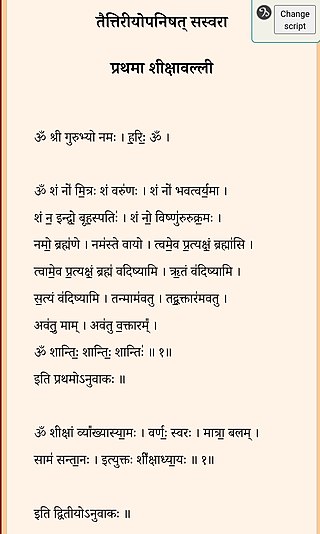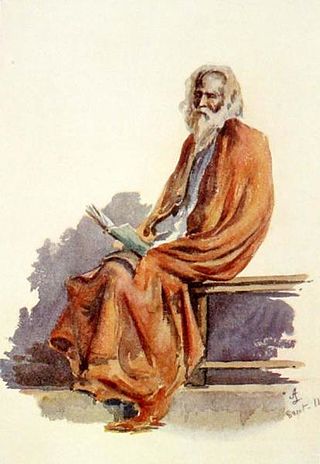Related Research Articles

The Upanishads are late Vedic and post-Vedic Sanskrit texts that "document the transition from the archaic ritualism of the Veda into new religious ideas and institutions" and the emergence of the central religious concepts of Hinduism. They are the most recent addition to the Vedas, the oldest scriptures of Hinduism, and deal with meditation, philosophy, consciousness, and ontological knowledge. Earlier parts of the Vedas dealt with mantras, benedictions, rituals, ceremonies, and sacrifices.

Yajnavalkya or Yagyavalkya is a Hindu Vedic sage featuring in the Brihadaranyaka Upanishad and Tattiriya Upanishad. Yajnavalkya proposes and debates metaphysical questions about the nature of existence, consciousness and impermanence, and expounds the epistemic doctrine of neti neti to discover the universal Self and Ātman. Texts attributed to him include the Yajnavalkya Smriti, Yoga Yajnavalkya and some texts of the Vedanta school. He is also mentioned in the Mahabharata as well as various Puranas, Brahmanas and Aranyakas.

A gurukula or gurukulam is a type of education system in ancient India with śiṣya living near or with the guru in the same house for a period of time where they learn and get educated by their guruji.

Upanayana is a Hindu educational sacrament, one of the traditional saṃskāras or rites of passage that marked the acceptance of a student by a preceptor, such as a guru or acharya, and an individual's initiation into a school in Hinduism. Some traditions consider the ceremony as a spiritual rebirth for the child or future dvija, twice born. It signifies the acquisition of the knowledge of and the start of a new and disciplined life as a brahmāchārya. According to the given community and its regional language, it is also known by numerous terms such as mekhal in Kashmiri (मेखल), janeo in Punjabi (ਜਨੇਓ), upnen/upvit in Rajasthani (उपनेन/उपवीत), jānoi in Gujrati (જાનોઇ), janya in Sindhi (जन्य), janev in Bhojpuri (जनेव), munja in Marathi (मुंजा), munji in Konkani (मुंजी), poite in Bangla (পৈতৈ), brataghara in Odia (ବ୍ରତଘର), logun dioni in Assamese, bratabandha in Nepali (ब्रतबन्ध), chewar in Newari (छेवार), upanayana in Kannada (ಉಪನಯನ), upanayanamu in Telugu (ఉపనయనము), upanayanam in Malayalam (ഉപനയനം), and upanayanam or pūṇūl in Tamil. The Upanayanam ceremony is arguably the most important rite for Brāhmaṇa, Kṣatriya, and Vaiśya males, ensuring his rights with responsibilities and signifying his advent into adulthood.
Brahmacharya is a concept within Indian religions that literally means "conduct consistent with Brahman" or "on the path of Brahman". Brahmacharya, a discipline of controlling the senses, is seen as a way to liberation. Though sexual restraint is a part of brahmacharya, brahmacharya encompasses all striving toward a passionless state.

The Brihadaranyaka Upanishad is one of the Principal Upanishads and one of the first Upanishadic scriptures of Hinduism. A key scripture to various schools of Hinduism, the Brihadaranyaka Upanisad is tenth in the Muktikā or "canon of 108 Upanishads".
In Indian religions and society, an acharya is a religious teacher in Hinduism and Buddhism and a spiritual guide to Hindus and Buddhists. The designation has different meanings in Hinduism, Buddhism and secular contexts.
Dvija means "twice-born". The concept is premised on the belief that a person is first born physically and at a later date is born for a second time spiritually, usually when he undergoes the rite of passage that initiates him into a school for Vedic studies. The term also refers to members of the three varnas in the traditional Hindu social system, or social classes — the Brahmins, Kshatriyas (warriors), and Vaishyas — whose samskara of the Upanayana initiation was regarded as a second or spiritual birth.
Gargi Vachaknavi was an ancient Indian sage and philosopher. In Vedic literature, she is honoured as a great natural philosopher, renowned expounder of the Vedas, and known as Brahmavadini, a person with knowledge of Brahma Vidya. In the Sixth and the eighth Brahmana of Brihadaranyaka Upanishad, her name is prominent as she participates in the brahmayajna, a philosophic debate organized by King Janaka of Videha and she challenges the sage Yajnavalkya with perplexing questions on the issue of atman (soul). She is also said to have written many hymns in the Rigveda. She remained a celibate all her life and was held in veneration by the conventional Hindus.
Maitreyi is an Indian philosopher who lived during the later Vedic period in ancient India. She is mentioned in the Brihadaranyaka Upanishad as one of two wives of the Vedic sage Yajnavalkya; she is estimated to have lived around the 8th century BCE. In the Hindu epic Mahabharata and the Gṛhyasūtras, however, Maitreyi is described as an Advaita philosopher who never married. In ancient Sanskrit literature, she is known as a brahmavadini.
Uddalaka Aruni, also referred to as Uddalaka or Aruni or Uddalaka Varuni, is a revered Vedic sage of Hinduism. He is mentioned in many Vedic era Sanskrit texts, and his philosophical teachings are among the center piece in the Brihadaranyaka Upanishad and Chandogya Upanishad, two of the oldest Upanishadic scriptures. A famed Vedic teacher, Aruni lived a few centuries before the Buddha, and attracted students from far regions of the Indian subcontinent; some of his students such as Yajnavalkya are also highly revered in the Hindu traditions. Both Aruni and Yajnavalkya are among the most frequently mentioned Upanishadic teachers in Hinduism.

In Hinduism, Brahman connotes the highest universal principle, the Ultimate Reality of the universe. In major schools of Hindu philosophy, it is the non-physical, efficient, formal and final cause of all that exists. It is the pervasive, infinite, eternal truth, consciousness and bliss which does not change, yet is the cause of all changes. Brahman as a metaphysical concept refers to the single binding unity behind diversity in all that exists.

The Taittiriya Upanishad is a Vedic era Sanskrit text, embedded as three chapters (adhyāya) of the Yajurveda. It is a mukhya Upanishad, and likely composed about 6th century BCE.

The Jabala Upanishad, also called Jabalopanisad, is a minor Upanishad of Hinduism. The Sanskrit text is one of the 20 Sannyasa Upanishads, and is attached to the Shukla Yajurveda.

The Paingala Upanishad is an early medieval era Sanskrit text and is one of the general Upanishads of Hinduism. It is one of the 22 Samanya (general) Upanishads, and its manuscripts survive in modern times in two versions. The shorter version of the manuscript is found attached to the Atharvaveda, while the longer version is attached to the Shukla Yajurveda. It presents a syncretic view of Samkhya and Vedanta schools of Hindu philosophy.

The Mahavakya Upanishad is a Sanskrit text and one of the minor Upanishads of Hinduism. It is attached to the Atharvaveda, and is classified as one of the 20 Yoga Upanishads. The text describes the nature of Atman and Brahman, then asserts that they are identical and liberation is the state of fully understanding this identity.
Vedic learning started in Mithila with the expansion of Vedic and Brahmanic culture eastwards along the Ganges plain. Some sources consider this centre of Brahminical study to form an Ancient Mithila University. From the 12th/13th to 15th century CE it was an important centre of Nyaya Shastra and logical sciences.

Yajnavalkya Ashram was a gurukul of the Indian philosopher Yajnavalkya. It is believed that Yajnavalkya got his enlightenment here. It is the place where he wrote many texts of Ancient Indian philosophy. He wrote Shatapatha Brahman, Yajnavalkya Smriti, Brihadaranyaka Upanishad, Yoga Yajnavalkya and many more. Yajnavalkya Ashram is situated at Jagban village of Madhubani district in Mithila region of Bihar.

Vedic Parishad or Parishad was a council of learned Brahmins and scholars in the ancient India. It is also known as Brahmasabhā. The Vedic Parishad was headed by a chief judge. The chief judge was called as Dharmādhikārin. It was often a kind of religious court in Vedic and Brahmanical period. It was the sovereign assembly to the meeting of learned Brahmins for discussion and debate between the scholars. According to R K Mukherjee, the Parishad resembles with the university of students belonging to various colleges. Parishad represents conducting debates under the chairmanship of its president. In ancient times, Parishad was the assembly of learned scholars called by the king to decide on the subjects of Vedas, Vedanga, Dharmashastra, religion etc. The decision taken by the Parishad was universal.
Bahudakshina Yajna was a famous scholarly Yajna organised by the King Janaka of Mithila at his court. It was organised in order to find the best Brahmagyaani or Brahma-nishtha or the greatest scholar of Vedas among the participating Brahmin scholars in the Yajna at the court. It is mentioned in the Indian philosophical text Brihadaranyaka Upanishad.
References
- 1 2 "Ancient Indian Education Brahmanical and Buddhist". INDIAN CULTURE. Retrieved 2022-09-08.
- ↑ "Brahmanical Definition & Meaning | YourDictionary". www.yourdictionary.com. Retrieved 2023-12-29.
- ↑ "Brahminical". Vocabulary.Com.
- 1 2 Jayapalan, N. (2005). History of Education in India. Atlantic Publishers & Dist. ISBN 978-81-7156-922-9.
- 1 2 Dane, Kane (2018-10-31). "Describe the features of Brahmanic Education of India". Owlgen. Retrieved 2022-09-08.
- ↑ "Aims of Education in Vedic and Brahmanic Age | Important". 2022-01-05. Retrieved 2022-09-08.
- ↑ "MODULE – I PROGRESS OF EDUCATION IN ANCIENT INDIAN SUBCONTINENT" (PDF). Mumbai University.
- ↑ "EDUCATIONAL SYSTEM OF KASHI: FROM VEDIC PERIOD TO ..." nebula.wsimg.com.
- ↑ "Guru Dakshina – from ancient to the modern world". EducationWorld. 2019-09-04. Retrieved 2022-09-15.
- ↑ Sharma, Ram Nath; Sharma, Rajendra Kumar (1996). History of Education in India. Atlantic Publishers & Dist. ISBN 978-81-7156-599-3.
- ↑ Sharma, Ram Nath; Sharma, Rajendra Kumar (1996). History of Education in India. Atlantic Publishers & Dist. ISBN 978-81-7156-599-3.
- ↑ "Top 9 Important Brahmanical Centres of Learning – Discussed !". Your Article Library. 2015-08-11. Retrieved 2022-10-11.